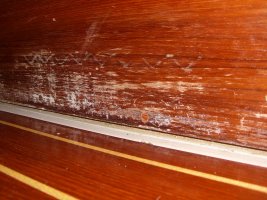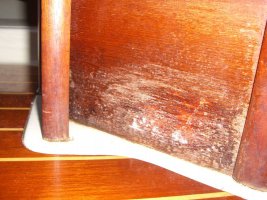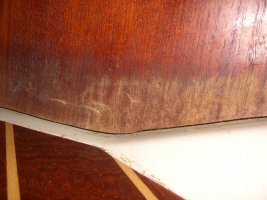Akavishon
Member III
When I took over my boat from the PO last year, I was told that at some point in the past the cabin sole was under water, and had to be replaced. Indeed, the sole looked pretty new, and there were visible water marks on the bottom of the teak bulkheads all around the cabin.
All last season, I had water intruding up the broken rudder post and gland, which kept the bilge and the teak wet (anytime the boat heeled, I suppose). This spring, I finally got that fixed and the bilge is now mostly dry, except after heavy rains.
I suppose that wood has now had a chance to dry out, and some white powdery substance has started appearing where there used to be water marks.
Is that the fabled dry rot? What is the best way to restore the wood, or at least limit the spread/damage? I've done a lot of searching on the web, but can't really find anything that would work well in my case ... any ideas?
pix attached ... If you look closely, the wood in the 3rd photo (in the v-berth) doesn't seem to be affected by this rot, or has not dried out yet?
thanks in advance, Zoran
All last season, I had water intruding up the broken rudder post and gland, which kept the bilge and the teak wet (anytime the boat heeled, I suppose). This spring, I finally got that fixed and the bilge is now mostly dry, except after heavy rains.
I suppose that wood has now had a chance to dry out, and some white powdery substance has started appearing where there used to be water marks.
Is that the fabled dry rot? What is the best way to restore the wood, or at least limit the spread/damage? I've done a lot of searching on the web, but can't really find anything that would work well in my case ... any ideas?
pix attached ... If you look closely, the wood in the 3rd photo (in the v-berth) doesn't seem to be affected by this rot, or has not dried out yet?
thanks in advance, Zoran



